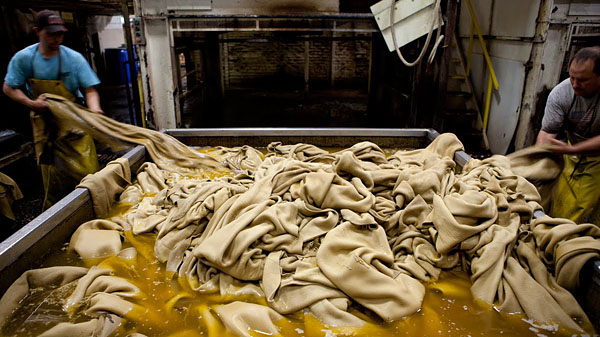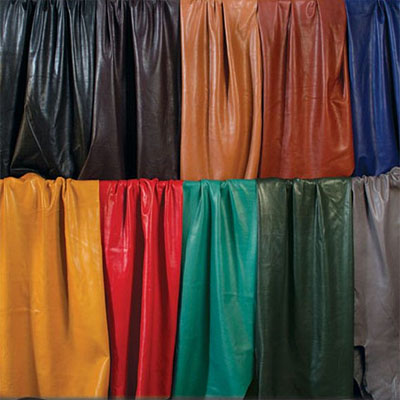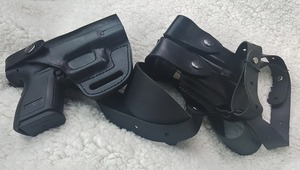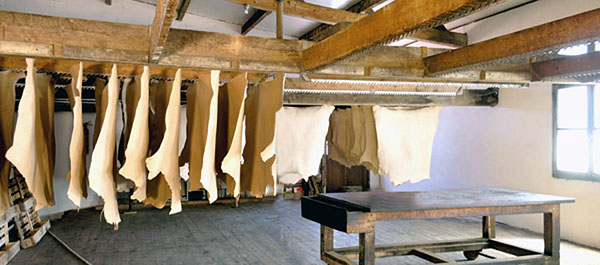People have used leather to make clothing, containers for carrying dry goods and liquids, harnesses, bridles, saddles, shoes and a multitude of other products for a very long time.

Can we hope to unearth an even older leather shoe in the future?
In fact, the world’s oldest leather shoe was recently discovered in 2008 in an Armenian cave and radiocarbon dated it all the way back some 5,500 years (3,500 B.C). It was so well preserved that it is tempting to conclude the leather tanning process played a major role towards its astonishing state of preservation. It even came with leather laces as seen in this image.
Leather can be made of any type of skin or hide; however, some types of skins are better for one purpose than another. For example, water buffalo hide is better for making saddles than shoes because it is very thick and tough. The most often used hides are from domestic cattle and sheep as they are far more readily available because they are consumed in huge numbers by us. However, wild elk and especially deer hides are getting more common nowadays too.
 In order to make leather soft and pliable for use, it must be put through a tanning leather process. This is a process that has been in use in one form or another for thousands of years. When you purchase leather goods, it is important to know how the leather was prepared. This is especially true for people who are very sensitive to chemicals.
In order to make leather soft and pliable for use, it must be put through a tanning leather process. This is a process that has been in use in one form or another for thousands of years. When you purchase leather goods, it is important to know how the leather was prepared. This is especially true for people who are very sensitive to chemicals.
Leather is usually tanned in one of two ways. One is chrome tanning, and the other is vegetable tanning. In this article, we will compare and contrast these two methods. But you can find the complete and definitive guide to vegetable tanning here.
Why Leather Is Tanned
The reason for tanning leather is to change the skin or hide’s protein structure. Tanning arrests the decaying process and changes the skin into leather. Once tanning is complete, the leather can be used to create a wide variety of leather goods. The skins or hides of domestic animals generally make the best leather.
The first step in tanning is to cure the skin by smoking, drying or salting it. Following this, excess flesh and hair are removed. After this, the skin must be washed and/or limed before it can be tanned.
What’s Good About Chrome Tanning?
 When chrome tanning is used, the leather will be soaked in a solution containing metal chromium. All but about 20% of animal hides tanned today are done so with this method. The technique can be altered in a variety of ways to create leather that is suitable for different uses.
When chrome tanning is used, the leather will be soaked in a solution containing metal chromium. All but about 20% of animal hides tanned today are done so with this method. The technique can be altered in a variety of ways to create leather that is suitable for different uses.
One good thing about chrome tanning is that it produces leather that is very water resistant.
At the same time, the leather feels soft and can be dyed with a wide variety of colors. The colors tend to set well and stay vibrant with the passage of time. The chrome tanning leather process also produces leather that endures heat better.
In addition, Chrome tanned leathers are about one third or even half the price of veg tanned leathers because it only takes up to 2 days to tan Chrome leather. But it takes up to 30 days, and in the case of traditional vegetable tanning, up to 1 year to complete the vegetable tanning process.
Because of these qualities and advantages, Chrome tanned leather is often called upholstery and garment leather as it is widely use to make leather furniture and clothing.
Problems With Chrome Tanning
On the other hand, this type of tanning process does not produce a very breathable sort of leather. As we have said, people with chemical sensitivities may have problems with chrome tanned leather. Additionally, the chemicals used in chrome tanning are bad for the environment. That’s why it is important to purchase leather goods that have been tanned in the United States. The environmental laws that are in place in the U.S & Europe ensure proper use and disposal of the chemicals for the least environmental impact.
 As a proud and mighty country that fiercely defends its Constitutional Right to Bear Arms, there has always been a demand for gun holsters in the U.S. and they are usually made with real leather.
As a proud and mighty country that fiercely defends its Constitutional Right to Bear Arms, there has always been a demand for gun holsters in the U.S. and they are usually made with real leather.
However, it is usually not ideal to use chrome tanned leather to make gun holsters and knife sheaths as the chromium salts in it will react with the metal on the gun and knife blade.
What’s Good About Vegetable Tanning
 For a more traditional and less hazardous tanning leather process, you may choose to purchase leather goods that have undergone vegetable tanning. This is a traditional method that uses natural materials and products. There are not many tanneries using 100% vegetable tanning process these days. With this method, the skins are soaked in vegetable tannins and fat liquors. This is a time consuming process as a series of soaks is required.
For a more traditional and less hazardous tanning leather process, you may choose to purchase leather goods that have undergone vegetable tanning. This is a traditional method that uses natural materials and products. There are not many tanneries using 100% vegetable tanning process these days. With this method, the skins are soaked in vegetable tannins and fat liquors. This is a time consuming process as a series of soaks is required.
Leather that has been vegetable tanned is usually quite thick, but it is still pliable. This type of leather can mold, stretch and breathe. This type of tanning process uses no dangerous chemicals or carcinogens, and it is much easier on the environment than chrome tanning.
You can stamp veg tanned leather, carve into it, wet formed it by hand into the shape of a mold cast, or even add grove lines into veg tanned leather, and it retains every bit of intricate detail.
Downside of Vegetable Tanning
Vegetable tanned leather is also a bit more delicate than chrome tanned leather. It does not stand up to heat as well and may shrink or crack if overheated.
Leathers that are created with vegetable tanning are not always uniform in appearance because they are dyed using natural ingredients such as the bark of pine, birch and oak trees. Additionally, they are not available in the vast array of colors that can be produced by chrome tanning.
With this all natural process, each piece of leather that is tanned becomes a unique item possessing its own, one of a kind rich, warm, natural shade. It develops a beautiful patina with the passing of time and while this can certainly be an upside for many people, it can make matching items of leather furniture a bit challenging. Because of the lengthy and labor intensive process involved, leather goods produced by vegetable tanning cost more than those produced through chrome tanning.
Is There An Alternative?
One tanning process combines vegetable and chrome tanning technique. This two-step process begins with chrome tanning. Once that process is complete, the resulting leather is tanned again using vegetable liquors. This combines the good elements of both methods.
The resulting leather is durable and soft because of the chrome tanning. It is also flexible and thick because of the vegetable tanning. This type of leather feels good and molds well. People with chemical sensitivities may have fewer problems with leather produced in this manner because the vegetable tanning process may help remove some of the chemicals used in the chrome tanning process.
Conclusion
As there are distinct advantages and disadvantages between the chrome and vegetable leather tanning processes, it is simply not possible to assert that one tanning process is superior to the other. Going forward, the only thing tanneries can possibly do are to continue to develop new techniques and innovations to maximize the strengths and qualities of both tanning processes and eliminate or reduce the disadvantages.